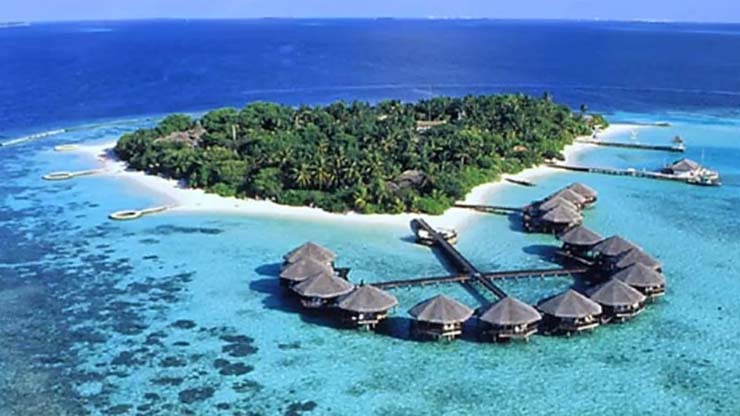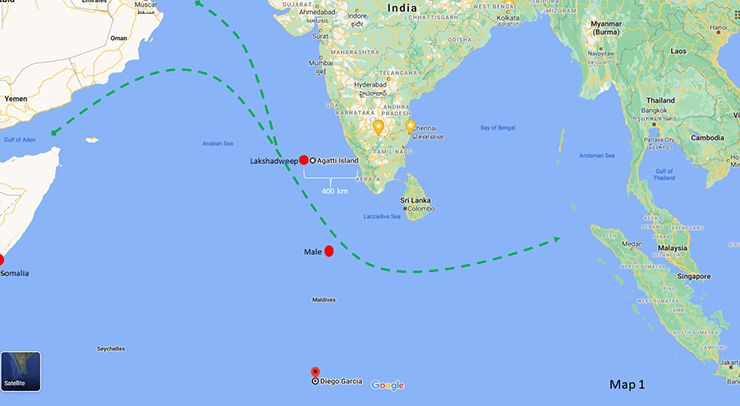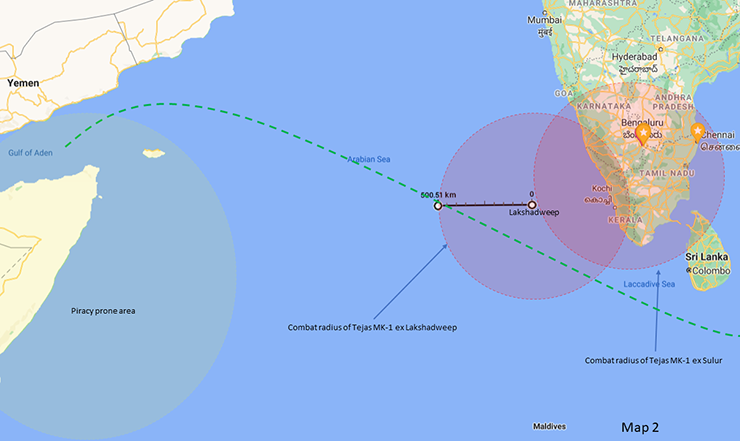
Lakshadweep is a picturesque group of 36 islands, famous for its rich biodiversity, blessed with the hue of natural opulence and surrounded by turquoise water bodies. The word Lakshadweep translates to ‘one lakh islands’ in Malayalam and Sanskrit, though the islands are just one part of the archipelago of no more than a hundred islands. Lakshadweep, with its untapped potential and strategic location, presents a unique opportunity for India to bolster its economic and security interests in the Indian Ocean region.
Who would have imagined that a simple trip by Prime Minister Modi to these SW frontiers on January 2, 2024, and a tweet highlighting its pristine beauty and untapped potential would cause an international-relations storm of epic proportions. Three junior ministers from the Maldives reacted strangely, posted disparaging and derogatory tweets followed by ‘Boycott Maldives’ call by Indian celebrities and Bollywood. All this has brought focus on Lakshadweep archipelago with thousands of travelers flooding the net with searches for tour packages to Lakshadweep.
Lakshadweep stands as sentinel in the Indian Ocean, overseeing the Sea Lines Of Communication that pass through the ‘Nine Degree Channel’ named after the latitude that passes through the archipelago. The channel is used by all merchantmen shuttling to and from Europe, the Middle East, West Asia, South East Asia, and the Far East
UNTAPPED POTENTIAL
For centuries, Lakshadweep has been a beauty spot in the vast expanse of the Indian Ocean. Only 10 of the 36 islands are inhabited and the total population is only about 73,000, smaller than an average town in India.
The scintillating Lakshadweep, which looks like emeralds embedded in a turquoise sea, attracts less than ten thousand tourists annually. Developing the islands by investing in infrastructure, promoting sustainable tourism, and strengthening security measures are crucial steps and by doing so, India can transform this undiscovered asset into a shining beacon of prosperity and security in the Indian Ocean region.

PIVOTAL LOCATION
Lakshadweep is an archipelago located 400 km to the west of Kerala. The islands have a total land area of just 32 sq km but confer a 400,000-sq km Exclusive Economic Zone (EEZ). Nearly 96 per cent of its population is Muslim and has a linguistic, cultural and religious affiliation with the people of Kerala. Lakshadweep stands as sentinel in the Indian Ocean, overseeing the Sea Lines Of Communication (SLOC) that pass through the ‘Nine Degree Channel’ named after the latitude that passes through the archipelago. Indian maritime agencies are keeping a close eye on the Nine Degree Channel, which separates Minicoy Island from the main Lakshadweep archipelago. The channel is used by all merchantmen shuttling to and from Europe, the Middle East and Western Asia, and South East Asia and the Far East.
Possession of these islands away from the mainland provides a strategic and political advantage to India. Therefore, the security and preservation of island territories from state and non-state actors is vital for India.
STRATEGIC IMPORTANCE
The strategic importance of these island groups, straddling the most heavily sailed international maritime trade routes in the Indian Ocean Region needs no emphasis. Lakshadweep has assumed strategic importance in recent years with the rise of China and its efforts to increase its presence in the Indian Ocean Region. On April 7, 2021, the USS John Paul Jones, a guided-missile destroyer, passed just off the coast of Lakshadweep. The proximity to Lakshadweep was indicative of the strategic importance of the archipelago. It is a matter of concern that all major powers of the world are competing to show their presence militarily, diplomatically and politically to gain a foothold in the Indian Ocean Region. Lakshadweep can serve India as a Strategic Sentinel, Maritime Guardian and certainly as a Diplomatic Asset in the Indian Ocean. Its strategic importance can be highlighted as follows:
Lakshadweep is an archipelago located 400 km to the west of Kerala. It has a total land area of just 32 sq km and only 10 of its 36 islands are inhabited. The total population is only about 73,000, smaller than an average town in India. Nearly 96 per cent of its population is Muslim and has a linguistic, cultural and religious affiliation with the people of Kerala
- Naval Outpost: Lakshadweep islands can serve as the naval outpost for Indian Naval assets deployed in the Arabian Sea.
- Monitor Smuggling: Lakshadweep may be used as a base for the smuggling of arms and narcotics in the country. Therefore, the area needs to be secured for internal security.
- Tackle Piracy: Lakshadweep can serve as a vantage point to monitor any movement of pirate vessels in the Arabian Sea.
- Shipping Lines: The Nine-Degree Channel near Lakshadweep is the shortest route for ships connecting West and East Asia. This can be effectively monitored from the Lakshadweep islands.
- Strategic Tool: Lakshadweep’s development can be used by India as a bargaining chip while dealing with China-favouring the Maldives.
- Joint Domination of Indian Ocean Region: Since India has emerged as a superpower in the geopolitics of the globe and other major regional powers are joining hands with India, Lakshadweep can be used as a hub for training and coordination of naval forces in the Indian Ocean Region. It is also strategically beneficial for joint exercises with friendly forces like
DEFENCE
The Indian defence establishment in Lakshadweep has been enhanced over the years. In 2010, India commissioned Coast Guard stations in Kavaratti and Minicoy islands, thus boosting the presence of the Indian Coast Guard. In 2012, the first naval base in the islands — INS Dweeprakshak, in the capital Kavaratti was commissioned. In the same year, another Coast Guard station was commissioned in Androth, where a naval detachment moved in 2016. Besides surveillance, these detachments work as observance and reporting units. They can be enhanced as logistics bases. There are plans for a fully operational navy base in Lakshadweep. A bigger facility on Minicoy is also under consideration, because of its proximity to the Maldives. The Indian Navy has a small presence in Lakshadweep, including naval air stations to conduct regional surveillance and monitoring operations. To achieve immense dominance over this region, India has to upgrade its military involvement in this region.

WAY AHEAD
After a prolonged period of neglect, Indian military planners are now starting to believe that Lakshadweep islands can be used to counter China’s growing influence in neighbouring nations such as the Maldives, Mauritius, Seychelles, Sri Lanka, Pakistan and Myanmar. India needs to reorient its thinking on these islands. These islands are not merely to be defended but India needs to develop these islands as a ‘strategic strongpoint.’ The geographical location of these islands provides a tactical advantage to India during conflicts. If the need arises, Lakshadweep can also be used as an ‘unsinkable aircraft carrier’ away from the coastline of India.
There is potential for India to develop dual-use facilities in Lakshadweep for military and civilian purposes. Airfields and naval jetties on the islands can be upgraded to accommodate more traffic and larger aircraft. Helipads can enable the quick movement of personnel and equipment across islands. Most islands already have accommodation, storage, and logistical facilities, which the Navy uses during training and patrols. These facilities can serve tourism and military needs alike, with most infrastructure development funding coming from the growing tourism industry.
There is potential for India to develop dual-use facilities in Lakshadweep for military and civilian purposes. Most islands already have accommodation, storage, and logistical facilities, which the Indian Navy uses during training and patrols. These facilities can serve tourism and military needs alike, with most infrastructure development funding coming from the growing tourism industry
The local resistance to Lakshadweep turning into a tourism and strategic hotspot stems from a range of concerns. There might be apprehensions about preserving the distinct cultural identity of the islands, with fears that increased tourism and strategic developments could lead to a dilution of local traditions and practices. The inclusion of locals must be the first step in this development process.
CONCLUSION
The current Lakshadweep-Maldives row is a spark that should propel us to take resolute steps to develop our island assets and bolster India’s maritime muscles. A well-orchestrated use of these islands, to further India’s foreign and strategic policy, is the present requirement of India. Secure and stable Island territories would be the launch pad for India to rediscover its great maritime and political influence in this region. A thoughtful and comprehensive defence-centric strategy would be the key to addressing the multifaceted challenges faced by this picturesque archipelago.
-The writer is an avid reader and prolific writer. Post retirement, he is a Social Activist, Career Consultant and a Motivational Speaker of repute. He can be contacted at www.majgencpsingh.com















